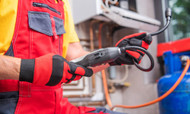Understanding How Photoionization Detectors Work
27th Nov 2023
Photoionization detectors (PIDs) play an indispensable role in monitoring dangerous substances, including volatile organic compounds (VOCs). VOCs are a group of carbon-based chemicals that easily evaporate at room temperature. They may cause immediate and long-term adverse health effects, such as dizziness, visual disorders, and memory impairment, when inhaled, and they can also contribute to air pollution. Learn how photoionization detectors work and explore their significance in detecting VOCs across various industries.
The Principle of Photoionization
Photoionization is when a particle of light, called a photon, interacts with an atom or molecule, causing it to lose an electron and become ionized. PIDs can detect VOCs by measuring the ions generated during this interaction. This detection method enables the device to identify the presence of tiny amounts of target compounds sensitively and selectively, making them indispensable safety tools.
Step One: The UV Lamp Emits Energy
The photoionization device contains a UV lamp that generates high-intensity photons needed to ionize the target molecules. The energy emitted by the lamp determines the range of compounds that the device can detect, with higher-energy lamps detecting more substances.
The sample inlet, placed near the lamp, allows air to enter the detector. Passing the air sample through a filter removes any interfering particulates for a more accurate reading.
Photon Energy Levels Determine Detectable Substances
PIDs can detect the presence of substances that the photons ionize. Detectable substances include VOCs, formaldehyde, and chlorinated hydrocarbons. However, if ionizing the molecule requires higher energy than the UV lamp can generate, then the PID cannot detect it. For example, PIDs cannot detect methane because the UV lamp cannot ionize it.
Step Two: Ionization of Molecules
When a sample of gas containing VOCs enters the detector, the UV lamp’s photons ionize the VOC molecules, detaching electrons from the molecules and producing positively charged ions.
Step Three: Collection and Amplification of Ions
One key to understanding how photoionization detectors work is knowing that ions are affected by electric fields. PIDs use electric fields to measure the presence and quantity of the generated ions.
Within the PID’s chamber, an arrangement of electrodes, under the influence of an electric field, attracts the newly formed ions and electrons. The positively charged ions rush toward electrodes with a negative potential—known as the cathode—while free electrons find their way to electrodes with a positive potential, or the anode. The flow of charged particles between the electrodes generates an electric current, which the device measures to determine the concentration of target molecules in the sample gas.
PIDs offer an effective way to monitor and detect harmful substances in various environments. Utilizing a UV lamp for ionization and an electric field for ion collection, these devices can accurately detect the presence and concentration of many compounds, protecting human health and environmental air quality.

